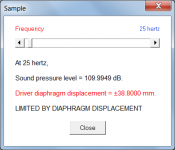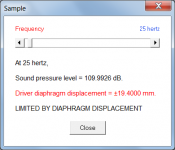Hello,
I came across this page on the internet:
http://www.baudline.com/erik/bass/xmaxer.html
Now I can enter all the values there and get the Xmax value I need to reach the required frequencies as an answer. So far so good, but only the diameter of the speaker driver is asked here and not the moving mass. I plan to make my driver relatively heavy and that should affect all of that as well. How exactly do I have to complete the calculations now? Or am I completely wrong and the mms plays no role here ?
I came across this page on the internet:
http://www.baudline.com/erik/bass/xmaxer.html
Now I can enter all the values there and get the Xmax value I need to reach the required frequencies as an answer. So far so good, but only the diameter of the speaker driver is asked here and not the moving mass. I plan to make my driver relatively heavy and that should affect all of that as well. How exactly do I have to complete the calculations now? Or am I completely wrong and the mms plays no role here ?
Xmax in the context of that calculator is how far the cone has to move to produce a given SPL, and that is independant of Mms.
Various other things do change with increased Mms (Fs in particular, and the necessary suspension to support it) but not Xmax.
Various other things do change with increased Mms (Fs in particular, and the necessary suspension to support it) but not Xmax.
X Max is purely a matter of Geometry, not of Dynamics.Hello,
I came across this page on the internet:
http://www.baudline.com/erik/bass/xmaxer.html
Now I can enter all the values there and get the Xmax value I need to reach the required frequencies as an answer. So far so good, but only the diameter of the speaker driver is asked here and not the moving mass. I plan to make my driver relatively heavy and that should affect all of that as well. How exactly do I have to complete the calculations now? Or am I completely wrong and the mms plays no role here ?
Xmax in the context of that calculator is how far the cone has to move to produce a given SPL, and that is independant of Mms.
Various other things do change with increased Mms (Fs in particular, and the necessary suspension to support it) but not Xmax.
So if I understood you correctly, MMs does not play a major role here. If I also want to achieve 25 Hz at 110 SPL with a 12 inch driver, do I need an Xmax of 38.82mm no matter what the MMS is?
and if i have 2 same drivers I need directly less xmax per driver to achieve the same ?
Mms taken purely by itself doesn't mean much. Xmax itself is also a fairly meaningless value unless a manufacturer happens to state exactly what they mean by it: there is no fixed industry-wide definition for what it even means, let alone a consistent method of generating a number that can be called Xmax (there are many definitions, even more methods, and most will give different numbers if applied to the same drive unit). It more or less dates to a point where measurement hardware was extremely expensive & of limited availability, and attempted to provide a [very] approximate guideline to motor linearity.
Yup, Mms is not directly tied to Xmax.So if I understood you correctly, MMs does not play a major role here. If I also want to achieve 25 Hz at 110 SPL with a 12 inch driver, do I need an Xmax of 38.82mm no matter what the MMS is?
and if i have 2 same drivers I need directly less xmax per driver to achieve the same ?
In a closed cabinet, which is what that website models for you, yes, that's the amount of excursion you need.
Yes again, using 2 drivers rather than one halves the amount of excursion each one needs.
If you can accept the tradeoffs involved, a vented cabinet would allow the same in-band SPL with even less Xmax.
That is a VERY tall order.If I also want to achieve 25 Hz at 110 SPL with a 12 inch driver,
I design and build speakers from scratch (meaning bulk steel sheet, plate and bar): just the magnetic system would be ginormous.
In fact, custom building a field coil assembly would be justified. go figure.
Even monster car subwoofers pale besides it.
do I need an Xmax of 38.82mm no matter what the MMS is?
Yes, it´s a pure Geometry problem, you need to move a certain volume of air.
Check out data-bass.com and the systems they have tested to reach 25 Hz at 110 dB in half space at 2 meters. This will give you an idea of what it takes....also want to achieve 25 Hz at 110 SPL with a 12 inch driver, do I need an Xmax of 38.82mm...
For a driver in an infinite baffle, the only thing that will affect the diaphragm displacement is the value of Sd. If Sd = 487 cm^2 then the peak diaphragm excursion or displacement required at 25 Hz to give an SPL of 110 dB is 38.8 mm. Attachment 1 refers.If I also want to achieve 25 Hz at 110 SPL with a 12 inch driver, do I need an Xmax of 38.82mm no matter what the MMS is?
For two drivers, the displacement of each driver is halved to 19.4 mm. Attachment 2 refers.and if i have 2 same drivers I need directly less xmax per driver to achieve the same ?
Attachments
When working with a famous UK speaker designer back in the late '70s I learnt something about subs which has truly stood the test of time:
"Move a Lot of Air - GENTLY"
If you want to reproduce bass accurately, then a large driver barely moving is usually going to sound better than a small one flapping around near Xmax - enter a large diameter driver into the calculator to see the effect, and bear in mind that Xmax for larger and properly rated PA drivers is typically 10-15mm. You should be more concerned with Sd if your aim is sound quality at a given spl; if not, you are firmly in car audio territory with their ludicrous driver displacements and one-note 'bass'. I would consider an 18" driver as an absolute minimum for your requirements, however I have gone up to 21" drivers now as they represent better value for money in terms of Vd/£!
"Move a Lot of Air - GENTLY"
If you want to reproduce bass accurately, then a large driver barely moving is usually going to sound better than a small one flapping around near Xmax - enter a large diameter driver into the calculator to see the effect, and bear in mind that Xmax for larger and properly rated PA drivers is typically 10-15mm. You should be more concerned with Sd if your aim is sound quality at a given spl; if not, you are firmly in car audio territory with their ludicrous driver displacements and one-note 'bass'. I would consider an 18" driver as an absolute minimum for your requirements, however I have gone up to 21" drivers now as they represent better value for money in terms of Vd/£!
- Home
- Loudspeakers
- Subwoofers
- Xmax calculation in relation with the moving mass

